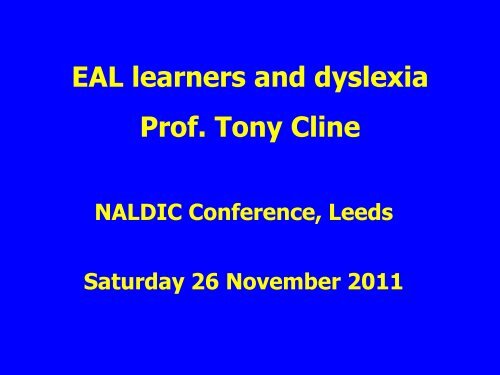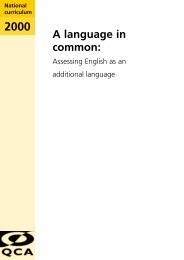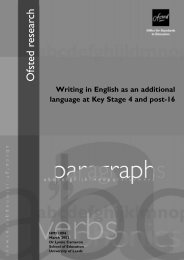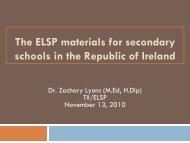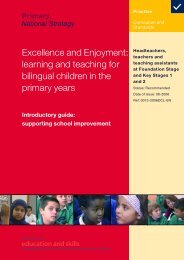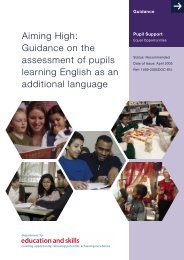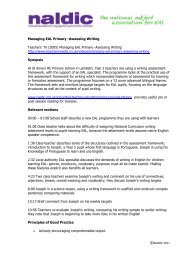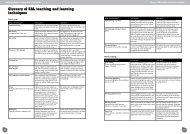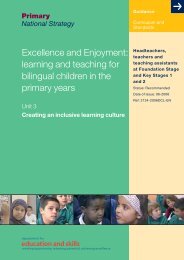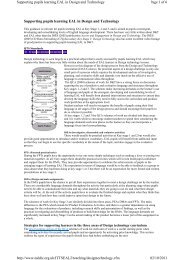EAL learners and dyslexia - NALDIC
EAL learners and dyslexia - NALDIC
EAL learners and dyslexia - NALDIC
Create successful ePaper yourself
Turn your PDF publications into a flip-book with our unique Google optimized e-Paper software.
<strong>EAL</strong> <strong>learners</strong> <strong>and</strong> <strong>dyslexia</strong>Prof. Tony Cline<strong>NALDIC</strong> Conference, LeedsSaturday 26 November 2011
Plan of the session1. An audit of the skills <strong>and</strong> knowledgeassociated with reading proficiency2. Identifying <strong>dyslexia</strong> in a child who islearning <strong>EAL</strong> <strong>and</strong> reading in English3. Basic strategies in teaching pupils with<strong>EAL</strong> who show learning difficulties inliteracyTony Cline, <strong>NALDIC</strong> Conference 19,26/11/20112
Plan of the session1. An audit of the skills <strong>and</strong>knowledge associated withreading proficiency2. Identifying <strong>dyslexia</strong> in a child who islearning <strong>EAL</strong> <strong>and</strong> reading in English3. Basic strategies in teaching pupils with<strong>EAL</strong> who show learning difficulties inliteracyTony Cline, <strong>NALDIC</strong> Conference 19,26/11/20113
An audit of the list on page 4of the h<strong>and</strong>outWhich of the skills <strong>and</strong> areas of knowledgelisted in the left h<strong>and</strong> column would expect tobe particularly weak in each of the childrendescribed at the top. Write a cross in that rowof the relevant column. Leave other cells blankbut put a question mark if you are not sure.Tony Cline, <strong>NALDIC</strong> Conference 19,26/11/20114
Audit of skills <strong>and</strong> knowledgeMonolingualchild who has<strong>dyslexia</strong>Early stage <strong>EAL</strong>learner withreading difficulty<strong>EAL</strong> learnerwho has<strong>dyslexia</strong>Tony Cline, <strong>NALDIC</strong> Conference 19,26/11/20115
2. Identifying <strong>dyslexia</strong>a) Weak phonic knowledge > underlying readingdifficulty?b) Weak reading comprehension < limitedunderst<strong>and</strong>ing of English?c) Computer-based test batteries – value <strong>and</strong>limitations?Tony Cline, <strong>NALDIC</strong> Conference 19,26/11/20116
3. Basic teaching strategiesa) Build on strengths <strong>and</strong> achievementsb) Compensate for areas of comparativeweakness when developing reading skillsc) Compensate for areas of comparativeweakness when developing writing skillsTony Cline, <strong>NALDIC</strong> Conference 19,26/11/20117
A) Build on strengths <strong>and</strong> achievementsA.1 Competence in other languages, includingliteracy knowledge <strong>and</strong> skillsA.2 Breadth of cultural experienceA.3 Phonological awareness <strong>and</strong> skillsA.4 MotivationA.5 Self-esteemTony Cline, <strong>NALDIC</strong> Conference 19,26/11/20118
B) Compensate for areas of weakness whendeveloping reading skills 1B.1 Consistent routines <strong>and</strong> dem<strong>and</strong>sB.2 Contextualising word-level teachingB.3 Culturally appropriate materialsB.4 Practice in cognitive <strong>and</strong> metacognitivestrategiesB.5 Activate/introduce appropriate schemaTony Cline, <strong>NALDIC</strong> Conference 19,26/11/20119
Compensate for areas of weakness whendeveloping reading skills 2B.6 Develop habit of advance organisingB.7 Constant checks on comprehensionB.8 Slow down reading rate - for a purposeB.9 Employ multisensory approachesB.10 Stress over-learning (in meaningfulcontexts)Tony Cline, <strong>NALDIC</strong> Conference 19,26/11/201110
Compensate for areas of weakness whendeveloping reading skills 3B.11 Modify tasks so that pupil can showcomprehension of what is read in a waythat does not place heavy dem<strong>and</strong>s onexpressive language or writing skillsB.12 Use pair <strong>and</strong> group work to enable peersto scaffold emerging skills <strong>and</strong> knowledgewith a struggling readerTony Cline, <strong>NALDIC</strong> Conference 19,26/11/201111
C) Compensate for areas of weakness whendeveloping writing skills 1C.1 Analyse the writing of children learning<strong>EAL</strong> closely so as to identify any specificdifficulties they may have with EnglishC.2 Draw <strong>learners</strong>’ attention to the roles thatadverbs <strong>and</strong> adverbial phrases playC.3 Expose <strong>EAL</strong> <strong>learners</strong> to different genres ofwritten EnglishTony Cline, <strong>NALDIC</strong> Conference 19,26/11/201112
Compensate for areas of weakness whendeveloping writing skills 2C.4 Draw <strong>learners</strong>’ attention to ways in whichwriters develop plots <strong>and</strong> characters, linkideas, bring stories to an end <strong>and</strong> usefeatures of grammar <strong>and</strong> give them direct(explicit) teaching in these aspects.C.5 Provide direct instruction about specificfeatures of writing <strong>and</strong> give detailedfeedback to children on their writing.Tony Cline, <strong>NALDIC</strong> Conference 19,26/11/201113
Compensate for areas of weakness whendeveloping writing skills 3C.6 Build on children’s cultural <strong>and</strong> linguisticexperiences by encouraging them to talkabout writing done at home <strong>and</strong> by forgingcloser links with families to underst<strong>and</strong> theways they try to support their children withwriting at home.Tony Cline, <strong>NALDIC</strong> Conference 19,26/11/201114
Questions• Which of those suggestions seems likelyto be helpful in working with pupils withsignificant learning difficulties whom youhave taught or are now teaching, inparticular those who are thought to have<strong>dyslexia</strong>?• What other suggestions would youmake?Tony Cline, <strong>NALDIC</strong> Conference 19,26/11/201115


